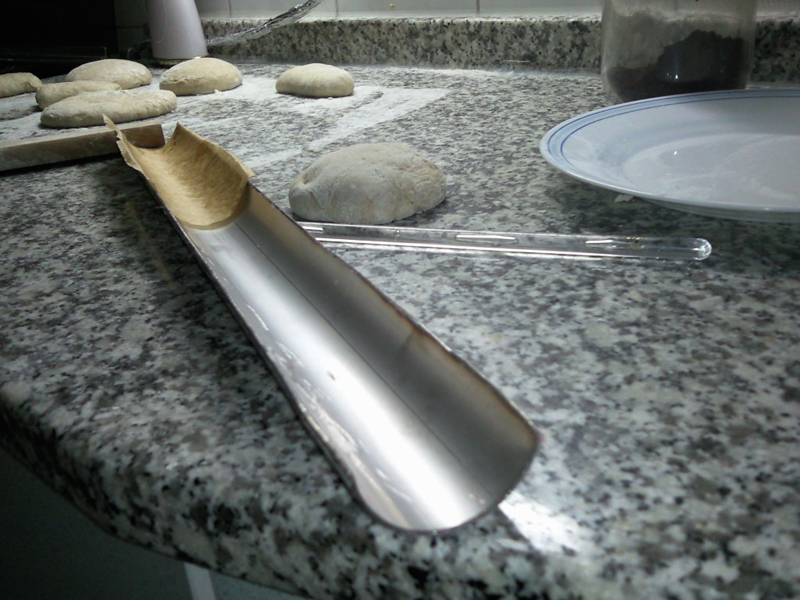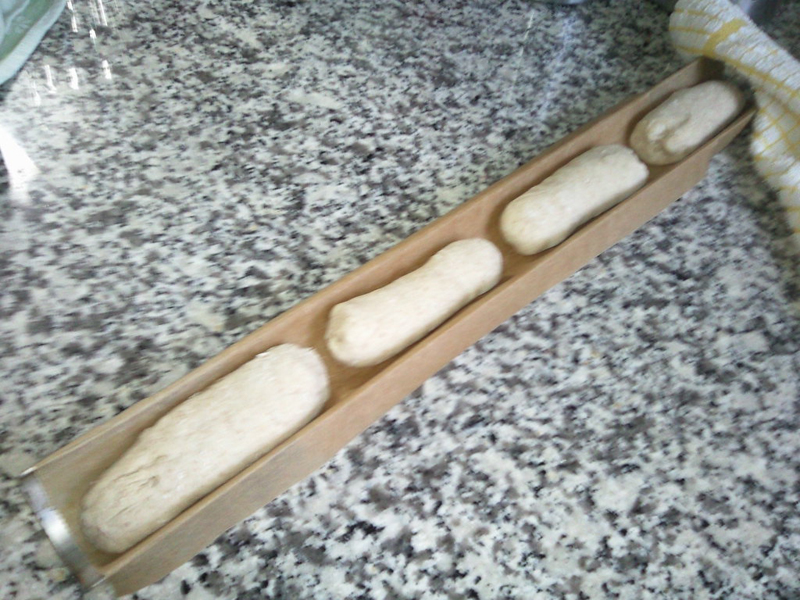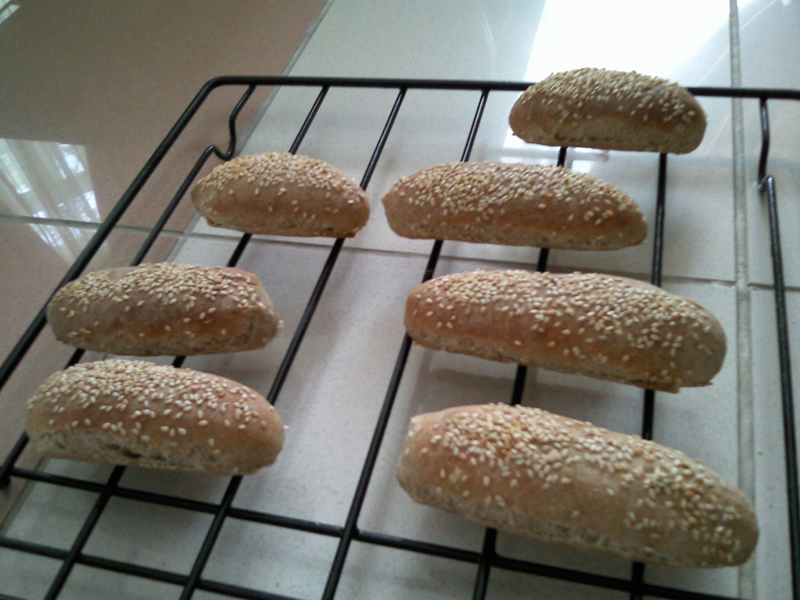Since i found no Baguette pan around, i decided, well as most home bakers would, to improvise. I bought a 6 meter stainless steel pipe i see in a hardware shop. Then, i asked him to cut it in 12 equal pieces of 1/2 meter each. Then, i took the lot to a workshop, and asked him to cut each one diagonally (split exch tube into equal halves. I'll let the pictures do the job:




As for the bread, it is 50% wholewheat,. 50% extra gluten AP flour.
Mebake
great improv and wonderful results !
Thanks Anna. I have yet to try the baguette, it should be more successful, i hope.
Mebake
Thats such a good idea!
Where did you find a workshop that would cut it in half?
And is your work surface always that tidy and clean?
Murvet
Your idea gives me one of my own. I have preformed perforated pans I haven't used in some time, and will try them with parchment paper this time, as you have. Now I have to dig up a recipe I can torture. I have a much smaller oven than yours. Mine is gas self cleaning I envy the space in your oven. Is that a Whirpool oven per chance? I meant to mention earlier that your idea is quite nice, and your breads look great as well. Ray
IT's very nice and looks cool, but I must say that a real baguette shouldn't be baked on a mold, but on the oven bottom. The well known baguette molds are used by supermarket bakeries or very low quality bakeries who bake in rotating ovens for speed and convenience.
Baking on a stone makes much better bread ;)
I mention this because long time ago my mother told me she wanted to make baguettes but couldn't because she doesn't have the molds and it really did hurt my feelings as a baker that she would think a real baguette is baked on mold!!!
If you see on a shop a baguette with perfectly rounded bottom with the tiny wholes (of the trays) it's usually the signature of a crappy baguette ;)
Cheers!!!
I'm a serious fan of baking on stone. However, assuming that baguettes baked in molds will usually turn out to be crappy seems a bit quick to me. Surely, the criteria should be taste, crumb, etc., instead of the way the bottom of a loaf looks. It might pay to be open to new ideas and experimentation. For example, wouldn't the molds allow a wetter dough, which would result in a very good loaf? OK, maybe you wouldn't want to call it a 'baguette' if you're a stickler for tradition. But if we were that serious about tradition, we'd have to give up our ovens too.
Murvet
France manufacture means nothing. The molds are made in China, as well.
Pay heed to Vincent's advice, because he is completely correct. And he happens to be an excellent baker: http://www.vincent.talleu.com/
and http://www.youtube.com/user/vincenttalleu#p/a/u/1/hhpxkGB1OyY
Any half decent "baguette de tradition" would be baked on the sole of the oven.It may have been made with high hydration, but then again, not necessarily. Somewhere between 60 and 70% would be the usual range. So many posts here on TFL give the real key to success with baguettes; the techniques are very difficult to master; and Vincent is a master.
The perforated baguette trays are just as Vincent states. They allow "bakers" to use easy rack ovens with billowing steam to produce imitation of the real thing.
They seem to be the norm in UK [our base] supermarkets and they are an abomination, made in 90 minutes, start to finish from average flour, far too much fresh yeast and a funny coloured sachet of dodgy chemicals, enzymes and other oddities.
Best wishes
Andy
..there are industrially produced baguettes in France too.
But baguette de tradition would be baked as Vincent describes
I haven't been to France in years, but I'm sure there is good bread, and very average bread available. I have read reasonably widely on the subject. Word from the likes of Stephen Kaplan is that good bread is returning.
Methinks he would not be counting baguettes made on stick wires as part of the "good bread"
BW
Andy
Vincent,
Every time I am feeling full of myself or need a kick in the pants to get me going, I go watch your video. You are a master craftsman in every sense and truly inspirational. Thank you!
Eric
Thanks ehanner! I'm not such a master trust me I'm just very good at pretending, I do lots of fuck ups and still have a lot to learn, the otherweek all my bread was slow and flat (sourdough) it was so bad I had to blame it on the flour and the weather :D:D
I can't wait until the petrol runs out that'll be really awesome, imagine all the bakeries with wood ovens, hand mixing, bicycle or horse home delivery, lots of fun in perspective!!! I'm just worried about the quantity of flour farmers/millers are gonna be able to deliver!:)
This thread is old, now, and after having seen hamelman's pictures in "BREAD" where a side by side comparision of baguettes baked on different surfaces was illustrated, i now am a believer of hearth baking.
However, here it goes:
Hey, Murvet! thanks, i found a workshop next to my office. It turns out that it costs $$ to cut them diagonally and file them. I like to keep my workspace as tidy as a could.
thanks Fred, i used parchment paper.
Thanks Ray! Nope that is just a regular supra oven, and yes it is spacious, thak God.
Khalid
Mebake,
You are a creative person who thinks laterally to solve problems. Your mind is thinking, "how can I adapt things I have to do the job". I applaud your solution and the process you thought out to get there. That's why your breads look so nice too.
I try to think about how would the bakers 500 years ago accomplish this job? Simplicity is the key.
Eric
Thanks Eric! i know i'll need these pans someday, if not, someone will! True thing Eric, simplicity is best.
Nice Pan there Dillbert! yours is more practical than mine!
Khalid
If you can find a sheet metal shop near you, have them spot weld the edges together of the two halves. That way they will lay flat together next to each other and be moved together more easily. The end result will be they will look like Dilberts forms.
I have one of these I bought that I use now and then when making a slack baguette dough. They minimize the worm effect from not getting the dough straight on the stone.
Eric
The thought has crossed my mind. I might do it someday.Until then,Eric, i'll stick to boules and batards for now..
So what SHOULD I use to make baguettes as an amateur. I want to make French bread or baguettes, and I was looking at molds. HOwever, this discussion has given me pause. I have a standard household electric oven, and I use 100% whole wheat in everything. With those parameters, what would you recommend?
By any chance do can you offer me a 100% whole wheat recipe to boot?
Thanks so much for helping out a beginner,
Sherri
but you might try these baguette forms which I use. I have the nonstick ones and found them very inexpensively online (I believe it was Amazon).
http://www.amazon.com/Chicago-Metallic-Commercial-Non-Stick-Perforated/dp/B003SZBSUK/ref=dp_ob_title_kitchen
Best,
anna
Hi, Sherry!
Which part of this thread have you paused upon? I say that because the thread topic was about molds, but the comments favored a free form baking, which i now support. If you wish to tread the easy way, you could use even flexible aluminum ducts, and cut them into molds. If you want to do the real deal , and get the maximum oven spring out of your oven you'll have to invest in time, flour, effort, to get the skill right. A normal electric oven is enough. You would have to include a means of steaming your oven without having steam escape excessively.
Iam glad that you bake with wholewheat. Invest in Peter Reinhart's Whole Grain Breads Book. He makes all Whole Wheat breads, including a baguette. You could also view my blog, or any of the Master Home Baker's at TFl's.
A Piece of advise: Baguettes with more than 50% wholewheat in them are not baguettes any more.
"Baguettes with more than 50% wholewheat in them are not baguettes any more."
Baguette is just a shape. If it's shaped like a baguette, it IS a baguette.